coolant temperature DODGE JOURNEY 2014 1.G Owners Manual
[x] Cancel search | Manufacturer: DODGE, Model Year: 2014, Model line: JOURNEY, Model: DODGE JOURNEY 2014 1.GPages: 651
Page 312 of 651
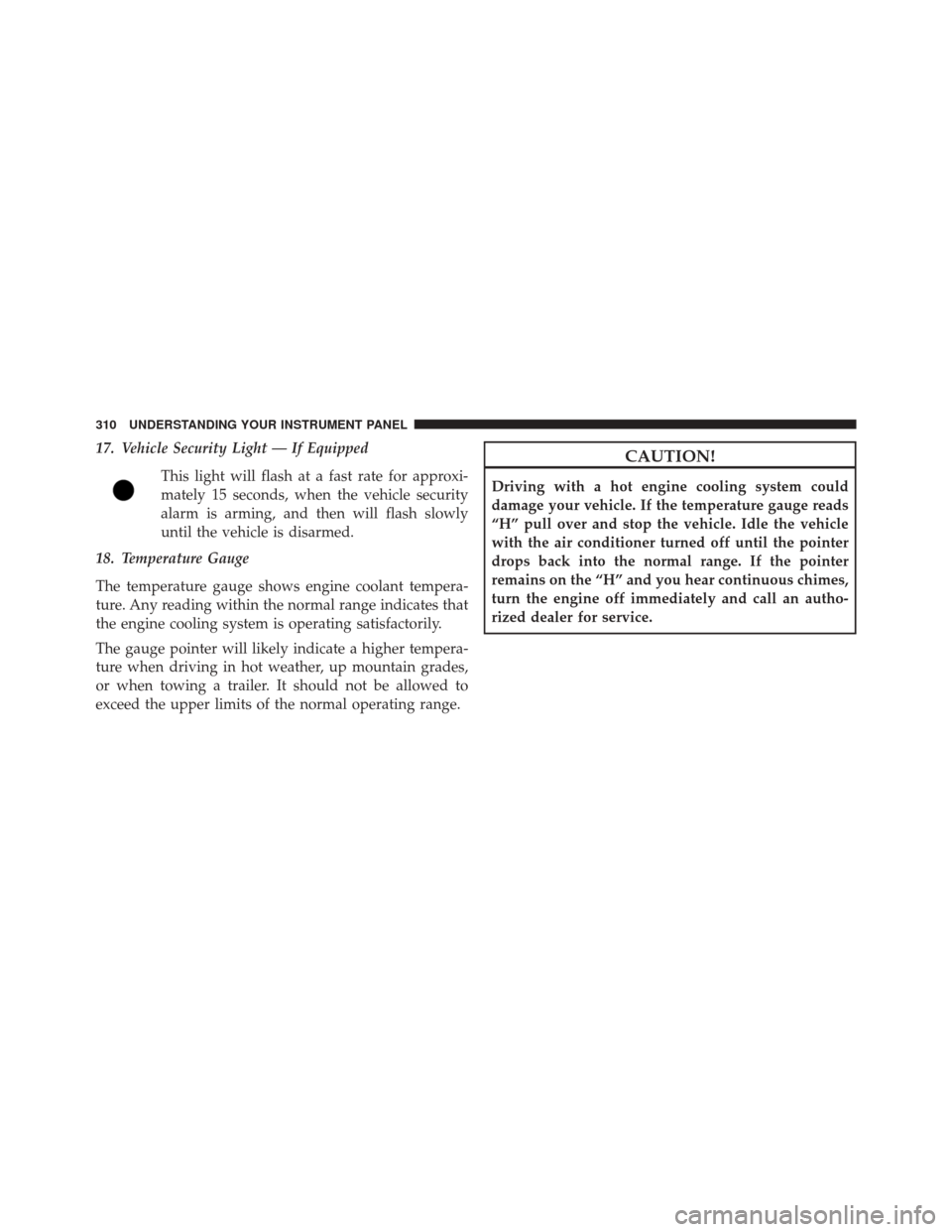
17. Vehicle Security Light — If EquippedThis light will flash at a fast rate for approxi-
mately 15 seconds, when the vehicle security
alarm is arming, and then will flash slowly
until the vehicle is disarmed.
18. Temperature Gauge
The temperature gauge shows engine coolant tempera-
ture. Any reading within the normal range indicates that
the engine cooling system is operating satisfactorily.
The gauge pointer will likely indicate a higher tempera-
ture when driving in hot weather, up mountain grades,
or when towing a trailer. It should not be allowed to
exceed the upper limits of the normal operating range.CAUTION!
Driving with a hot engine cooling system could
damage your vehicle. If the temperature gauge reads
“H” pull over and stop the vehicle. Idle the vehicle
with the air conditioner turned off until the pointer
drops back into the normal range. If the pointer
remains on the “H” and you hear continuous chimes,
turn the engine off immediately and call an autho-
rized dealer for service.
310 UNDERSTANDING YOUR INSTRUMENT PANEL
Page 326 of 651
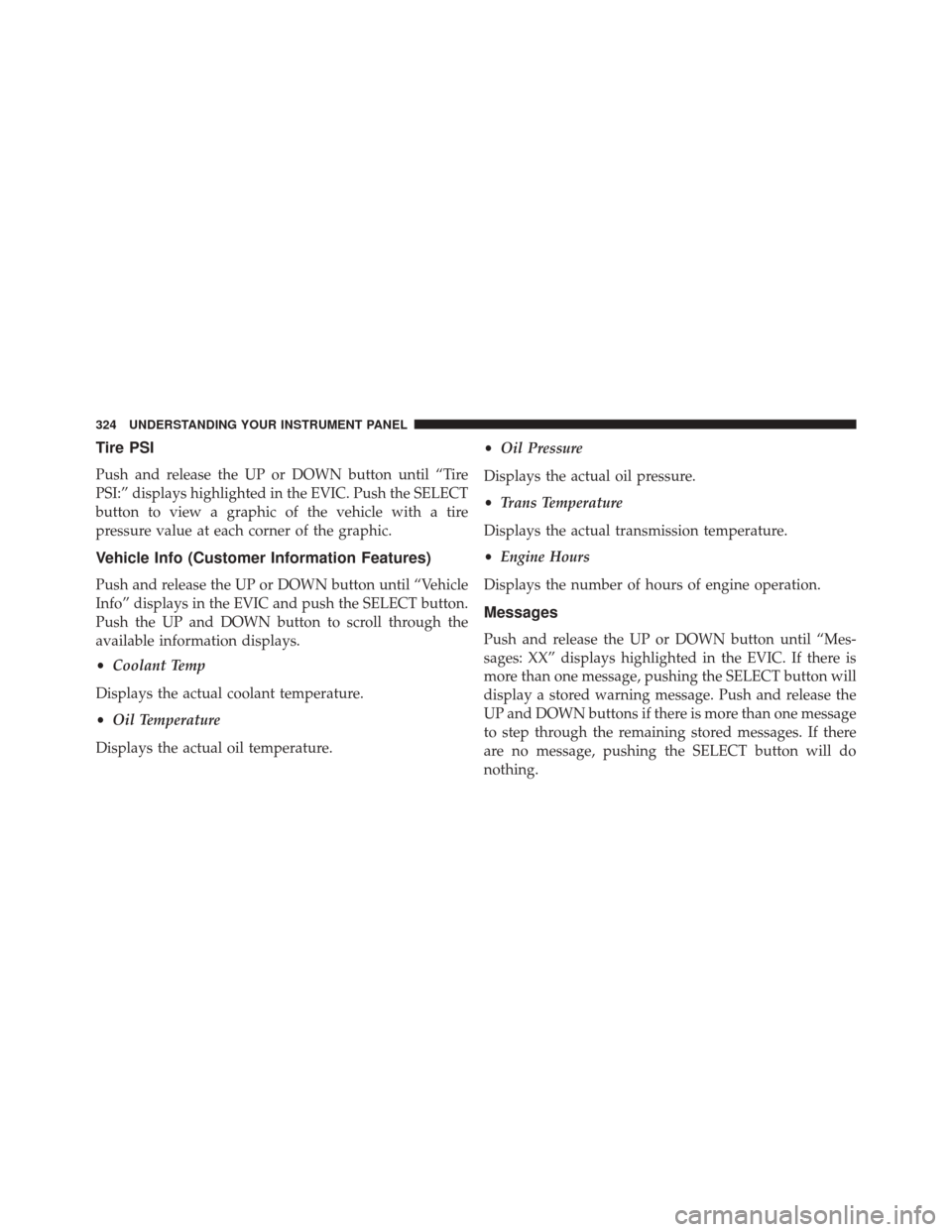
Tire PSI
Push and release the UP or DOWN button until “Tire
PSI:” displays highlighted in the EVIC. Push the SELECT
button to view a graphic of the vehicle with a tire
pressure value at each corner of the graphic.
Vehicle Info (Customer Information Features)
Push and release the UP or DOWN button until “Vehicle
Info” displays in the EVIC and push the SELECT button.
Push the UP and DOWN button to scroll through the
available information displays.
•Coolant Temp
Displays the actual coolant temperature.
• Oil Temperature
Displays the actual oil temperature. •
Oil Pressure
Displays the actual oil pressure.
• Trans Temperature
Displays the actual transmission temperature.
• Engine Hours
Displays the number of hours of engine operation.
Messages
Push and release the UP or DOWN button until “Mes-
sages: XX” displays highlighted in the EVIC. If there is
more than one message, pushing the SELECT button will
display a stored warning message. Push and release the
UP and DOWN buttons if there is more than one message
to step through the remaining stored messages. If there
are no message, pushing the SELECT button will do
nothing.
324 UNDERSTANDING YOUR INSTRUMENT PANEL
Page 518 of 651
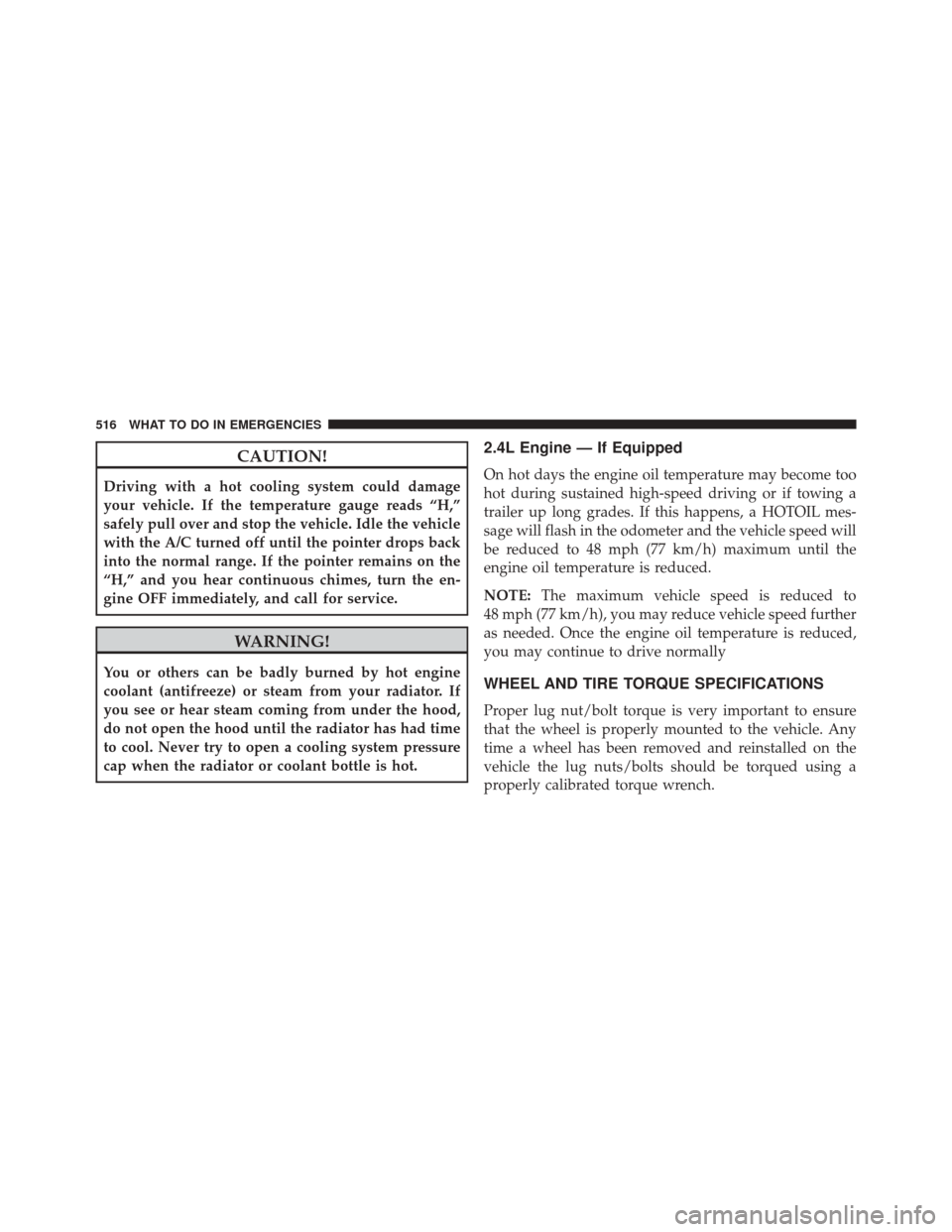
CAUTION!
Driving with a hot cooling system could damage
your vehicle. If the temperature gauge reads “H,”
safely pull over and stop the vehicle. Idle the vehicle
with the A/C turned off until the pointer drops back
into the normal range. If the pointer remains on the
“H,” and you hear continuous chimes, turn the en-
gine OFF immediately, and call for service.
WARNING!
You or others can be badly burned by hot engine
coolant (antifreeze) or steam from your radiator. If
you see or hear steam coming from under the hood,
do not open the hood until the radiator has had time
to cool. Never try to open a cooling system pressure
cap when the radiator or coolant bottle is hot.
2.4L Engine — If Equipped
On hot days the engine oil temperature may become too
hot during sustained high-speed driving or if towing a
trailer up long grades. If this happens, a HOTOIL mes-
sage will flash in the odometer and the vehicle speed will
be reduced to 48 mph (77 km/h) maximum until the
engine oil temperature is reduced.
NOTE:The maximum vehicle speed is reduced to
48 mph (77 km/h), you may reduce vehicle speed further
as needed. Once the engine oil temperature is reduced,
you may continue to drive normally
WHEEL AND TIRE TORQUE SPECIFICATIONS
Proper lug nut/bolt torque is very important to ensure
that the wheel is properly mounted to the vehicle. Any
time a wheel has been removed and reinstalled on the
vehicle the lug nuts/bolts should be torqued using a
properly calibrated torque wrench.
516 WHAT TO DO IN EMERGENCIES
Page 571 of 651
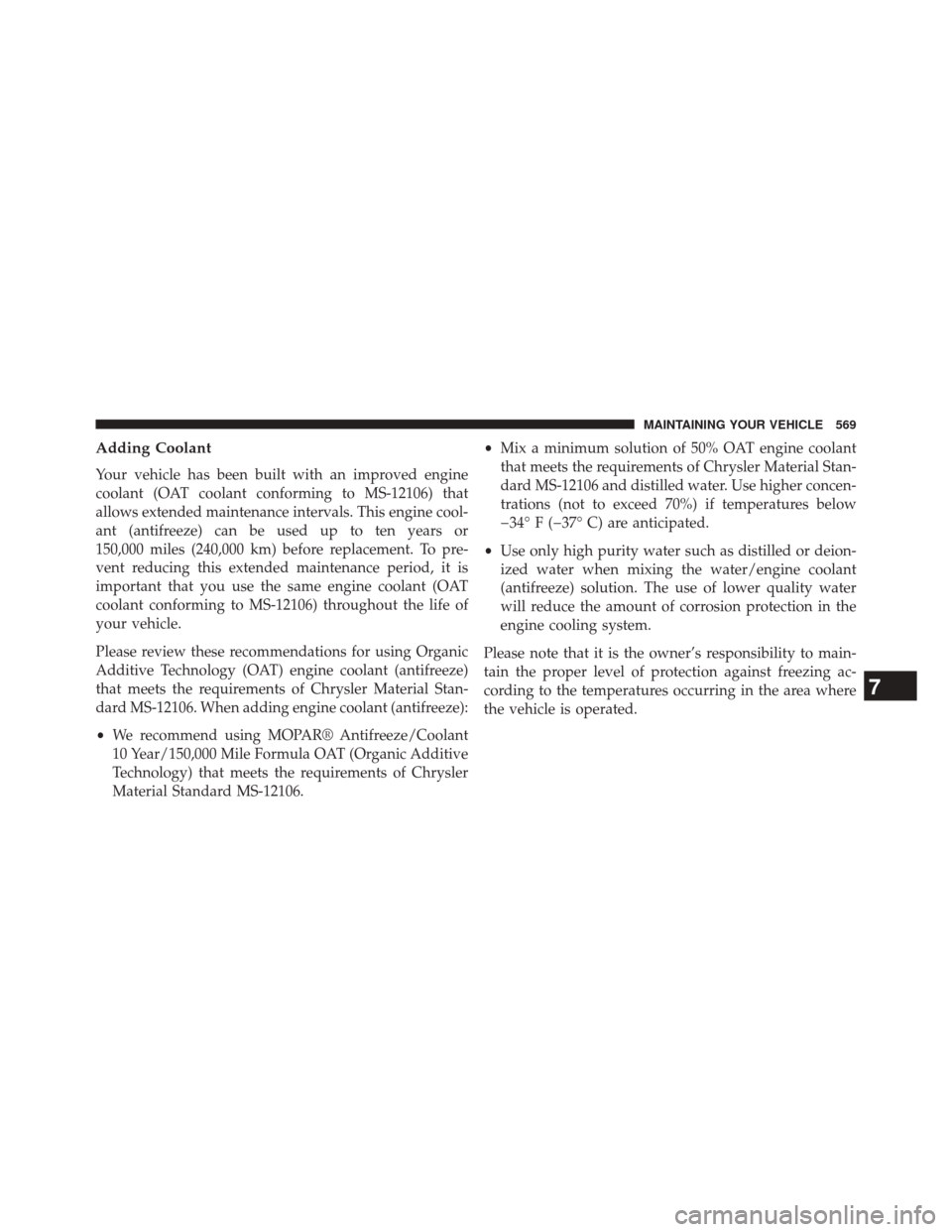
Adding Coolant
Your vehicle has been built with an improved engine
coolant (OAT coolant conforming to MS-12106) that
allows extended maintenance intervals. This engine cool-
ant (antifreeze) can be used up to ten years or
150,000 miles (240,000 km) before replacement. To pre-
vent reducing this extended maintenance period, it is
important that you use the same engine coolant (OAT
coolant conforming to MS-12106) throughout the life of
your vehicle.
Please review these recommendations for using Organic
Additive Technology (OAT) engine coolant (antifreeze)
that meets the requirements of Chrysler Material Stan-
dard MS-12106. When adding engine coolant (antifreeze):
•We recommend using MOPAR® Antifreeze/Coolant
10 Year/150,000 Mile Formula OAT (Organic Additive
Technology) that meets the requirements of Chrysler
Material Standard MS-12106. •
Mix a minimum solution of 50% OAT engine coolant
that meets the requirements of Chrysler Material Stan-
dard MS-12106 and distilled water. Use higher concen-
trations (not to exceed 70%) if temperatures below
�34° F (�37° C) are anticipated.
• Use only high purity water such as distilled or deion-
ized water when mixing the water/engine coolant
(antifreeze) solution. The use of lower quality water
will reduce the amount of corrosion protection in the
engine cooling system.
Please note that it is the owner’s responsibility to main-
tain the proper level of protection against freezing ac-
cording to the temperatures occurring in the area where
the vehicle is operated.
7
MAINTAINING YOUR VEHICLE 569
Page 573 of 651
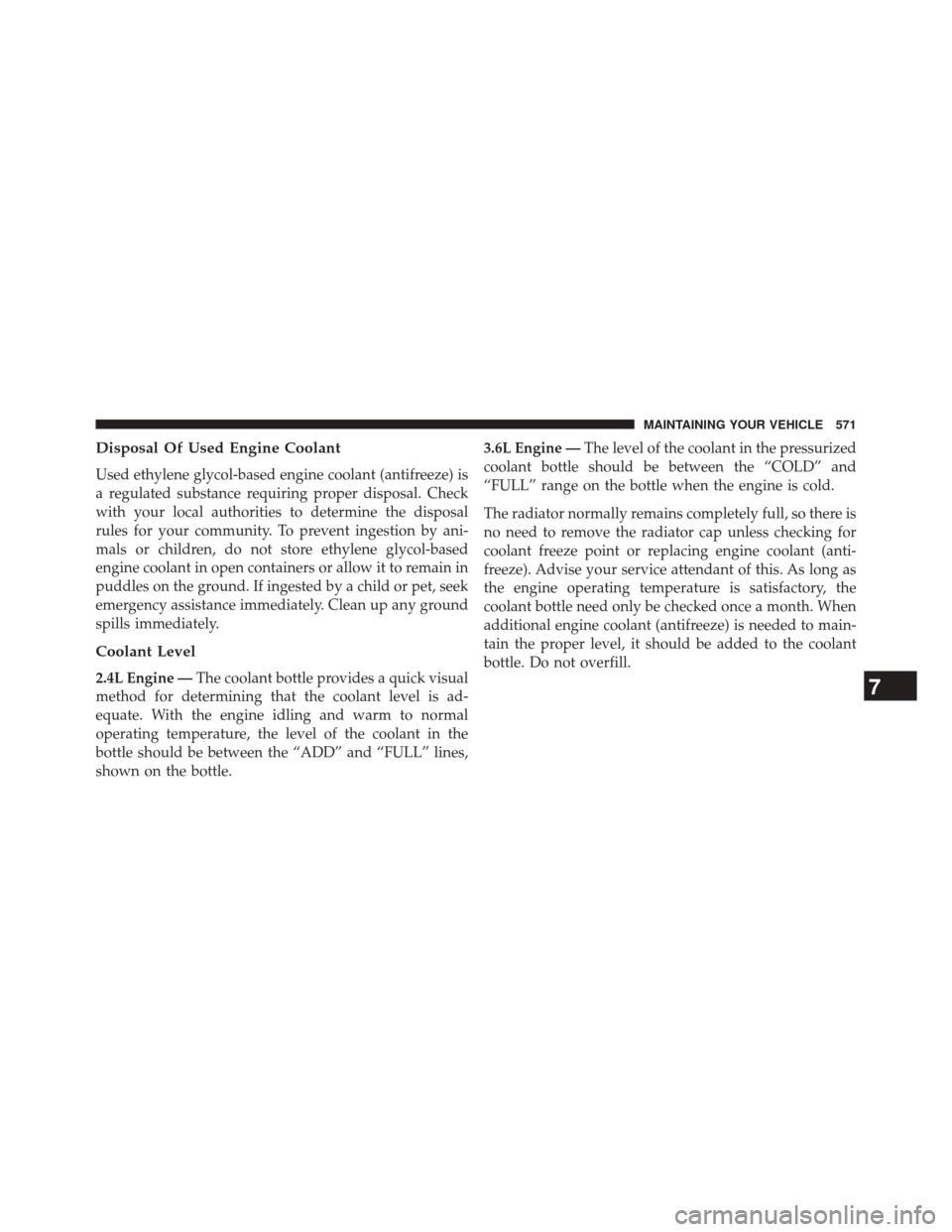
Disposal Of Used Engine Coolant
Used ethylene glycol-based engine coolant (antifreeze) is
a regulated substance requiring proper disposal. Check
with your local authorities to determine the disposal
rules for your community. To prevent ingestion by ani-
mals or children, do not store ethylene glycol-based
engine coolant in open containers or allow it to remain in
puddles on the ground. If ingested by a child or pet, seek
emergency assistance immediately. Clean up any ground
spills immediately.
Coolant Level
2.4L Engine —The coolant bottle provides a quick visual
method for determining that the coolant level is ad-
equate. With the engine idling and warm to normal
operating temperature, the level of the coolant in the
bottle should be between the “ADD” and “FULL” lines,
shown on the bottle. 3.6L Engine —
The level of the coolant in the pressurized
coolant bottle should be between the “COLD” and
“FULL” range on the bottle when the engine is cold.
The radiator normally remains completely full, so there is
no need to remove the radiator cap unless checking for
coolant freeze point or replacing engine coolant (anti-
freeze). Advise your service attendant of this. As long as
the engine operating temperature is satisfactory, the
coolant bottle need only be checked once a month. When
additional engine coolant (antifreeze) is needed to main-
tain the proper level, it should be added to the coolant
bottle. Do not overfill.7
MAINTAINING YOUR VEHICLE 571
Page 633 of 651
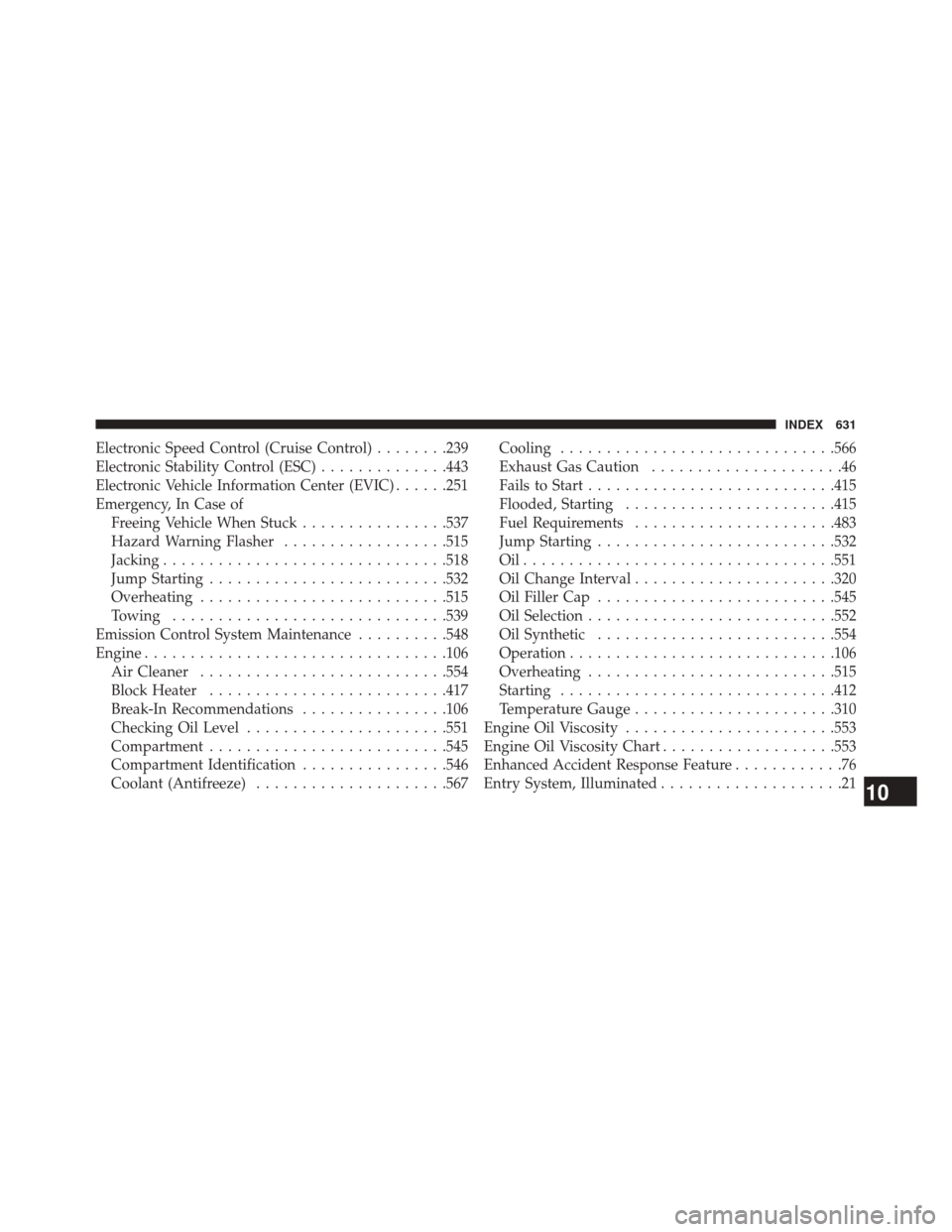
Electronic Speed Control (Cruise Control)........239
Electronic Stability Control (ESC) ..............443
Electronic Vehicle Information Center (EVIC) ......251
Emergency, In Case of Freeing Vehicle When Stuck ................537
Hazard Warning Flasher ..................515
Jacking ...............................518
Jump Starting ..........................532
Overheating .......................... .515
Towing ............................. .539
Emission Control System Maintenance ..........548
Engine .................................106
Air Cleaner .......................... .554
Block Heater ..........................417
Break-In Recommendations ................106
Checking Oil Level ..................... .551
Compartment ..........................545
Compartment Identification ................546
Coolant (Antifreeze) .....................567 Cooling
............................. .566
Exhaust Gas Caution .....................46
Fails to Start .......................... .415
Flooded, Starting .......................415
Fuel Requirements ..................... .483
Jump Starting ..........................532
Oil..................................551
Oil Change Interval ..................... .320
Oil Filler Cap ..........................545
Oil Selection .......................... .552
Oil Synthetic ..........................554
Operation ............................ .106
Overheating .......................... .515
Starting ............................. .412
Temperature Gauge ..................... .310
Engine Oil Viscosity .......................553
Engine Oil Viscosity Chart ...................553
Enhanced Accident
Response Feature............76
Entry System, Illuminated ....................21
10
INDEX 631
Page 635 of 651
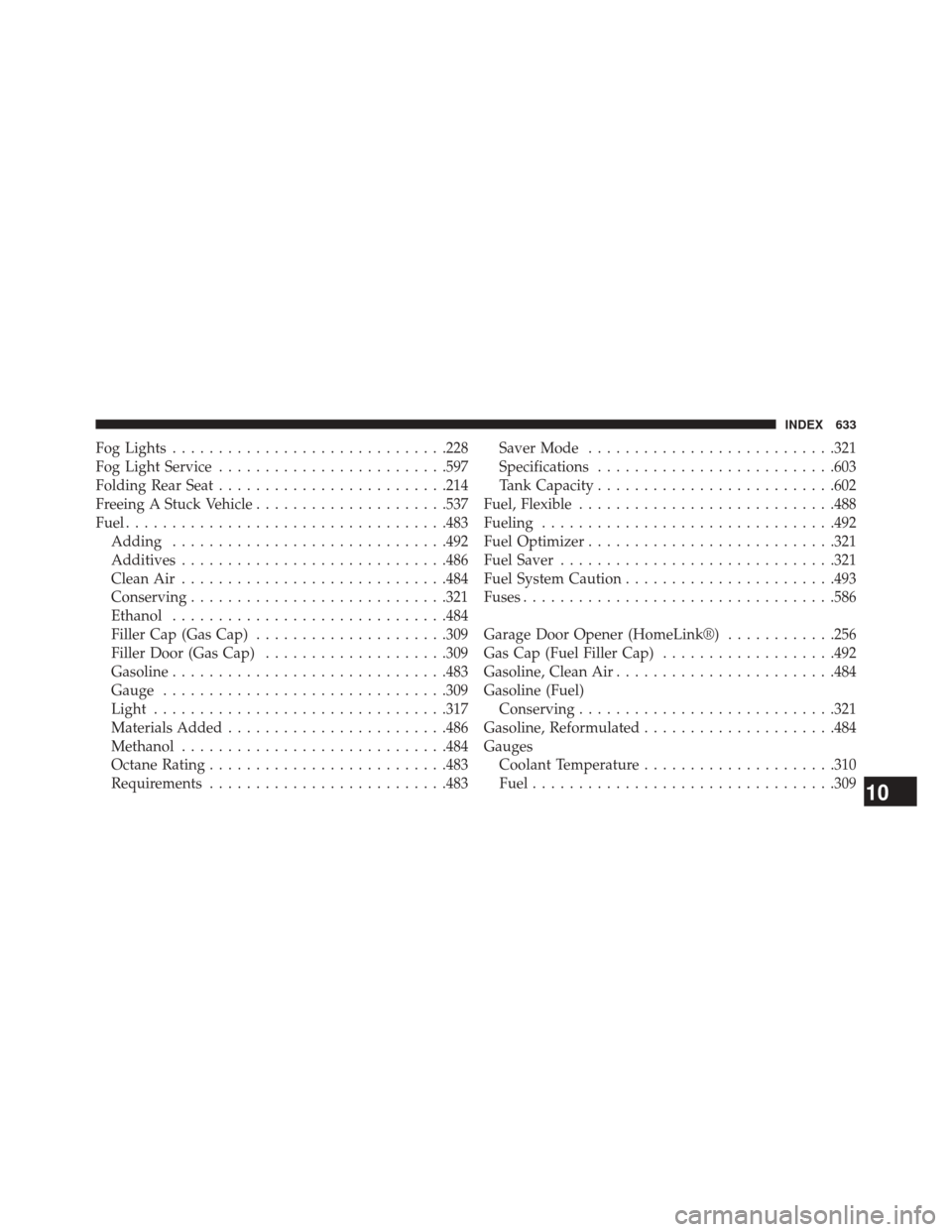
Fog Lights............................. .228
Fog Light Service ........................ .597
Folding Rear Seat ........................ .214
Freeing A Stuck Vehicle .....................537
Fuel .................................. .483
Adding ............................. .492
Additives ............................ .486
Clean Air ............................ .484
Conserving ............................321
Ethanol ............................. .484
Filler Cap (Gas Cap) .....................309
Filler Door (Gas Cap) ....................309
Gasoline ............................. .483
Gauge ...............................309
Light ............................... .317
Materials Added ........................486
Methanol ............................ .484
Octane Rating ..........................483
Requirements ..........................483 Saver Mode
.......................... .321
Specifications ..........................603
Tank Capacity ..........................602
Fuel, Flexible ............................488
Fueling ............................... .492
Fuel Optimizer .......................... .321
Fuel Saver ............................. .321
Fuel System Caution .......................493
Fuses ................................. .586
Garage Door Opener (HomeLink®) ............256
Gas Cap (Fuel Filler Cap) ...................492
Gasoline, Clean Air ........................484
Gasoline (Fuel) Conserving ............................321
Gasoline, Reformulated .....................484
Gauges Coolant Temperature .....................310
Fuel .................................309
10
INDEX 633
Page 646 of 651
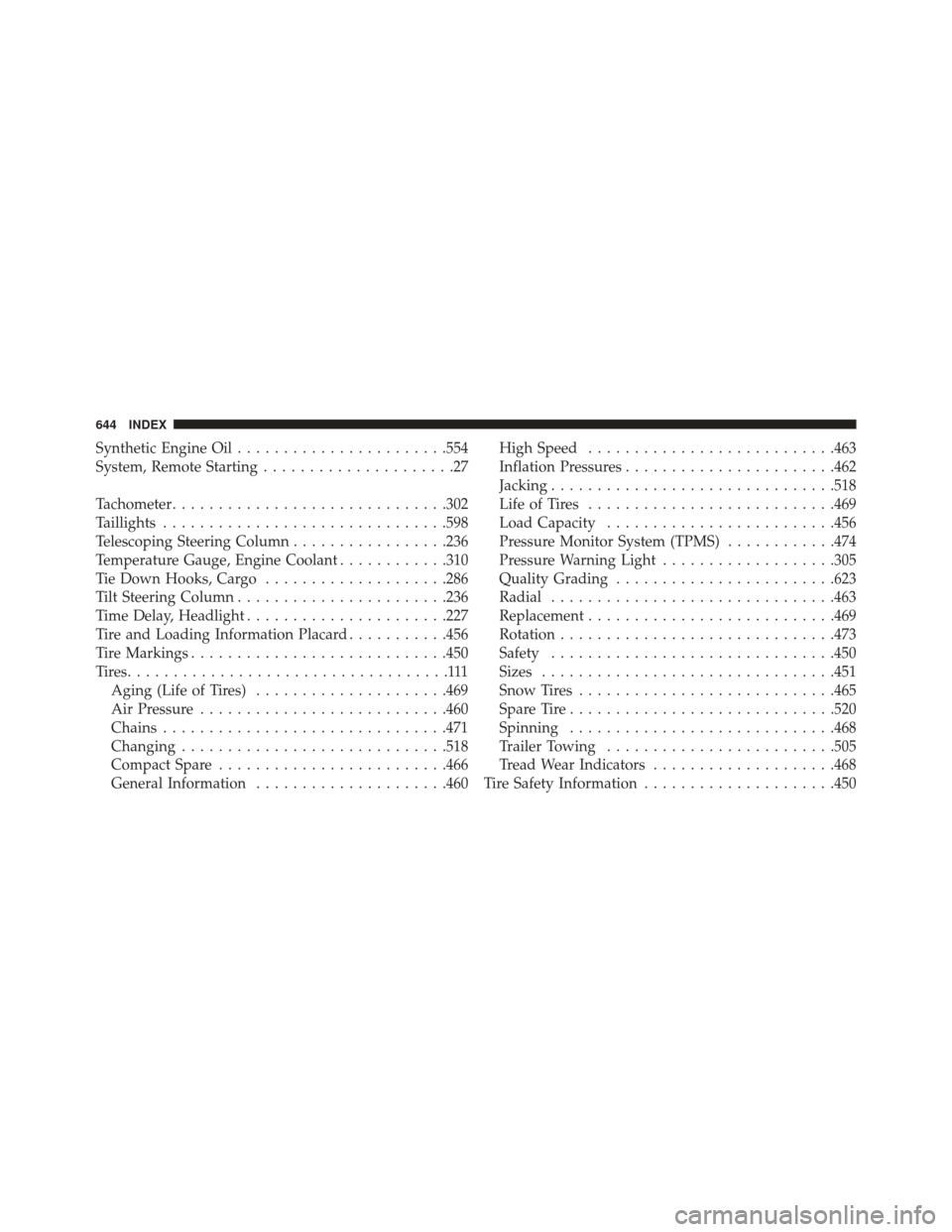
Synthetic Engine Oil.......................554
System, Remote Starting .....................27
Tachometer ............................. .302
Taillights ...............................598
Telescoping Steering Column .................236
Temperature Gauge, Engine Coolant ............310
Tie Down Hooks, Cargo ....................286
Tilt Steering Column .......................236
Time Delay, Headlight ..................... .227
Tire and Loading Information Placard ...........456
Tire Markings ............................450
Tires...................................111 Aging (Life of Tires) .....................469
Air Pressure .......................... .460
Chains ...............................471
Changing ............................ .518
Compact Spare ........................ .466
General Information .....................460 High Speed
.......................... .463
Inflation Pressures .......................462
Jacking ...............................518
Life of Tires .......................... .469
Load Capacity ........................ .456
Pressure Monitor System (TPMS) ............474
Pressure Warning Light ...................305
Quality Grading ........................623
Radial ...............................463
Replacement .......................... .469
Rotation ............................. .473
Safety ...............................450
Sizes ............................... .451
Snow Tires ............................465
Spare Tire ............................ .520
Spinning ............................ .468
Trailer Towing ........................ .505
T r
ead Wear Indicators ....................468
Tire Safety Information .....................450
644 INDEX